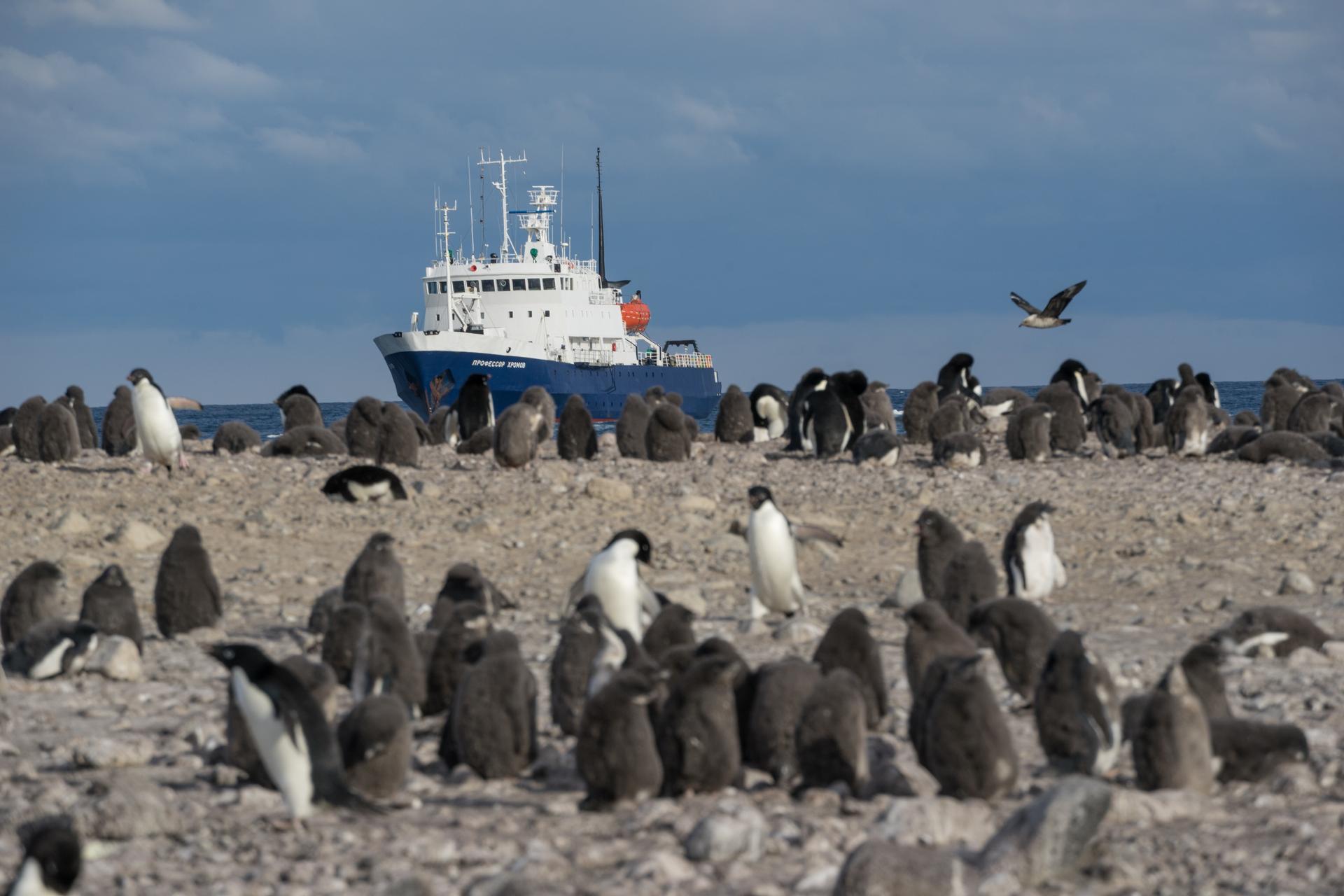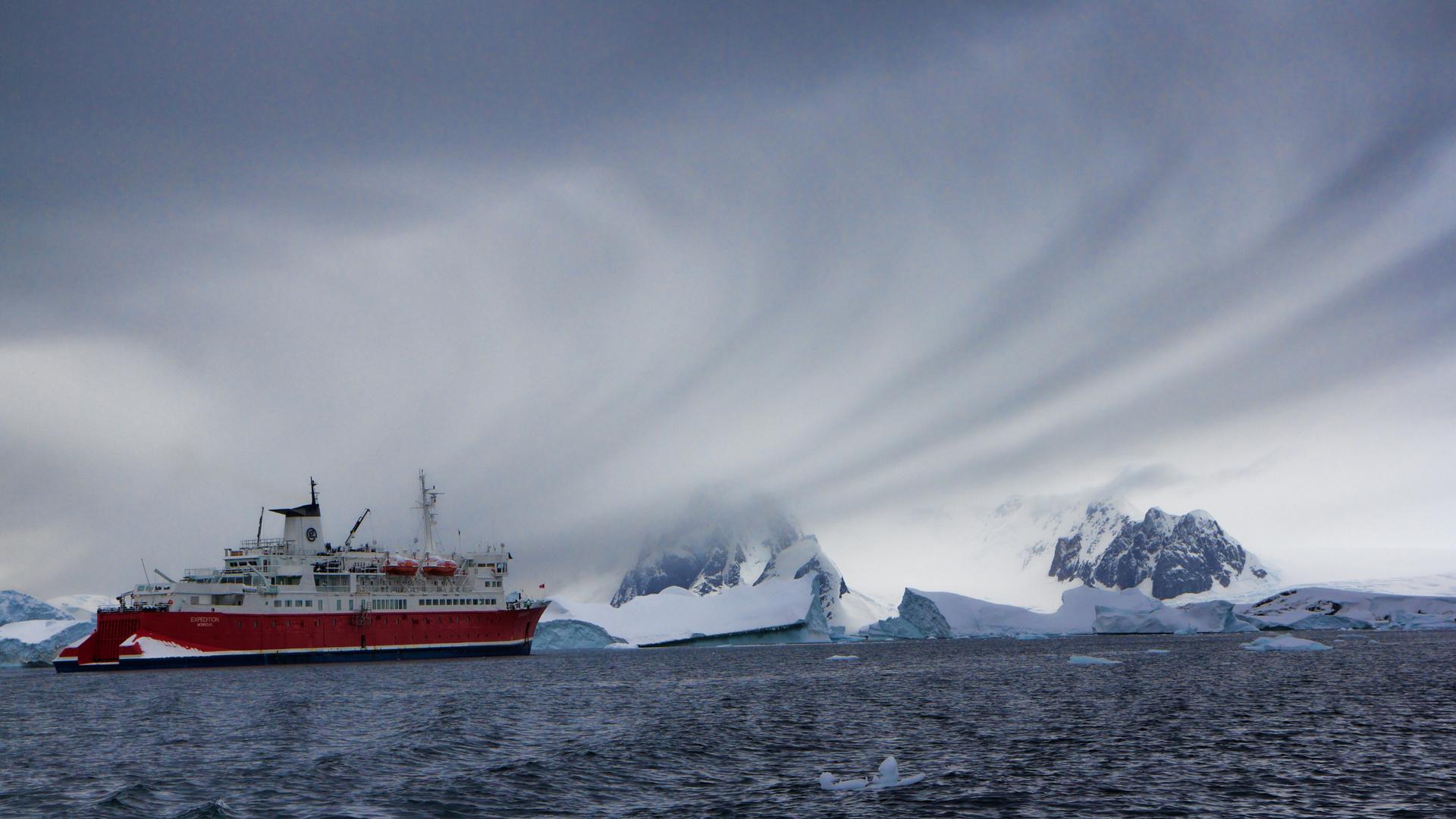Antarctica needs humans to protect it. It also needs humans to stay away. What’s a potential visitor to do?
A ship carrying tourists plies the waters off Antarctica.
Sherry Ott has been all over the world. Borneo, Mongolia, Nepal — she writes about travel for a living.
But Antarctica was different.
It’s “the closest you can get to leaving this planet,” Ott says. “This was the first place ever that I had been where clearly people were not in charge.”
No one even knew Antarctica existed until the late 1700s. It’s likely than no human set foot on the remote continent until at least the 1820s. And a century later, people had still barely begun exploring it.
Even today, with 40 permanent research stations and dozens of ships plying its waters in the summertime, Ott says she was struck on her visit last year by how untouched it still felt.
“It was the wildlife that owned this land,” she says. “One of my best days on Earth was being able to just sit on the beach, and king penguins would just walk right up to you, and the stiller you sat, pretty soon you get surrounded by them.”
There were something like 60,000 penguins, all waddling around and squawking.
And then there’s the ice. Antarctica as we know it is almost completely covered in ice, and that’s a huge part of the drama of being there. The sight and sound of massive icebergs breaking apart can be unforgettable.
Ott says traveling to Antarctica was life-changing, and she says part of her wishes everyone could experience what she did.
“I wish everyone could see it once, somehow, and have that feeling of being in a place where humans aren’t in charge.”
But she says the other part of her isn’t so sure.
“I want people to go to Antarctica, and I don’t.”
That’s because when you do see Antarctica, it’s hard to ignore how climate change is affecting the place, and the whole planet. And as a visitor, you contribute to that crisis, and to melting that huge block of ice.
Related: An Ominous new report on Antarctic melting
By one count, a two-week trip from the US to Antarctica produces 25 tons of carbon pollution, the very stuff that’s causing the atmosphere to warm up.
And there are lots of visitors to Antarctica these days — about 40,000 tourists a year, and more than 4,000 scientists and support staff.

Last year, Ott says she saw the effects of climate change in action when her tour leader steered his ship toward an Antarctic island. He’d been going there for decades, but in tourist season the quickest route would usually be blocked by ice, and the ship would have to take a longer route.
This time, though, Ott says it was so warm that the ice had melted and the ship could go straight through.
For Ott, it was “one of those ‘uh-oh’ moments,” one of those moments when climate change is no longer an abstract, distant problem we hear about on the news. Ott was seeing its effects right in front of her, and it created a sort of moral dilemma.
As a writer, “I’m kind of making it worse,” she says. “Because then I come back and I write about these places and I get people excited about going there, and I’m perpetuating the problem even more.”
Related: Climate change brings melting ice, and cruise passengers, to a small town in Canada’s north
Other visitors, including scientists, experience a similar dilemma.
Heather Lynch is a professor of ecology and evolution at Stony Brook University in New York who goes to Antarctica frequently. And she says every trip racks up a big “carbon debt.”
“All of us, scientists included, come back every year in debt,” Lynch says. “And we spend the rest of that year repaying that debt.”
Lynch says she helps repay her carbon debt through her research, which focuses on how climate change is affecting penguins.
And here’s a twist: To do that work, she and her colleagues actually depend on tourist ships to ferry them back and forth, for free. Otherwise, she says, “we would have to spend hundreds of thousands of dollars a year just on paying for those trips.”
In lieu of paying her way, Lynch gives onboard lectures about her work.
Scientists sometimes benefit from the tourist trips in other ways, too, like when paying passengers collect air samples or share photos of whales.
So science and tourism have forged kind of an alliance in Antarctica, but it’s an alliance that just increases that carbon debt.
And there are other impacts to consider when humans travel to the region — the impacts of just being there.
“When we’re standing there and we have snot running out of our nose and cells coming off our body, technically it’s pollution,” says Justine Shaw, a conservation scientist at the University of Queensland in Australia. “Because we’re introducing bacteria and viruses that have never been [there].”
Almost all tour operators follow strict protocols about contaminants, down to detailed instructions on how to wash your boots every time you get on and off the ice.
But Shaw says even with careful guidelines, humans can introduce things like flies and invasive weeds, which take full advantage of warming temperatures to take root in this new habitat.
Related: Antarctica is getting greener. And that’s not necessarily a good thing.
It definitely gives her pause.
“The easy thing to do would be to say everyone put down your tools, put down your toys, walk away and just let Antarctica do its thing,” Shaw says. “But that’s not going to happen.”
Scientists need to go to Antarctica to study everything from climate change to astrophysics.
And Shaw agrees that tourism plays an important role.
“No tourist goes to Antarctica and comes back and says, ‘ah, yeah, it’s not that great,’” she says.
Just the opposite — Shaw says everyone who goes there is moved by its beauty and uniqueness, and comes to understand what a risk climate change is to the place.
In some cases, visitors even make a pledge to advocate for its protection. That’s what happened on Ott’s expedition.

But does visiting Antarctica really change what people do when they get back? Are all those impacts really worth it?
“It’s the existential question, I think, with conservation in general,” says Robert Powell, a professor of parks and environmental ethics at Clemson University.
Powell used to be a guide in Antarctica, and as an academic, he has surveyed tourists before trips to Antarctica, immediately after, and then a few months later.
He found that tourists generally were moved by their experience. He says they intended to change behaviors and become ambassadors for Antarctica, and were inspired to donate to groups that protect the region and to avoid products that harm the environment.
But later, he says, once they’ve slid back into their regular lives, “in a lot of cases, folks just fall into their everyday patterns.”
Overall, Powell found no significant change in behavior.
But he has found a few dramatic exceptions, like the pastor of a megachurch whose Antarctica voyage inspired him to start a national campaign to get evangelical Christians to act on climate change.
Not everyone will have such a strong reaction, Powell says, “but we hear many people that have changed careers, and really have these sort of epiphanies on these trips.”
And Powell says even those rare experiences are important.
But does it ultimately balance out? Does tourism help? Or does it hurt Antarctica?
Powell admits that for that essential question, there’s just no easy answer.
Related: Don’t let Antarctica’s size fool you. It’s melting fast.
A version of this story originally appeared on an episode of WHYY’s The Pulse.
Our coverage reaches millions each week, but only a small fraction of listeners contribute to sustain our program. We still need 224 more people to donate $100 or $10/monthly to unlock our $67,000 match. Will you help us get there today?
